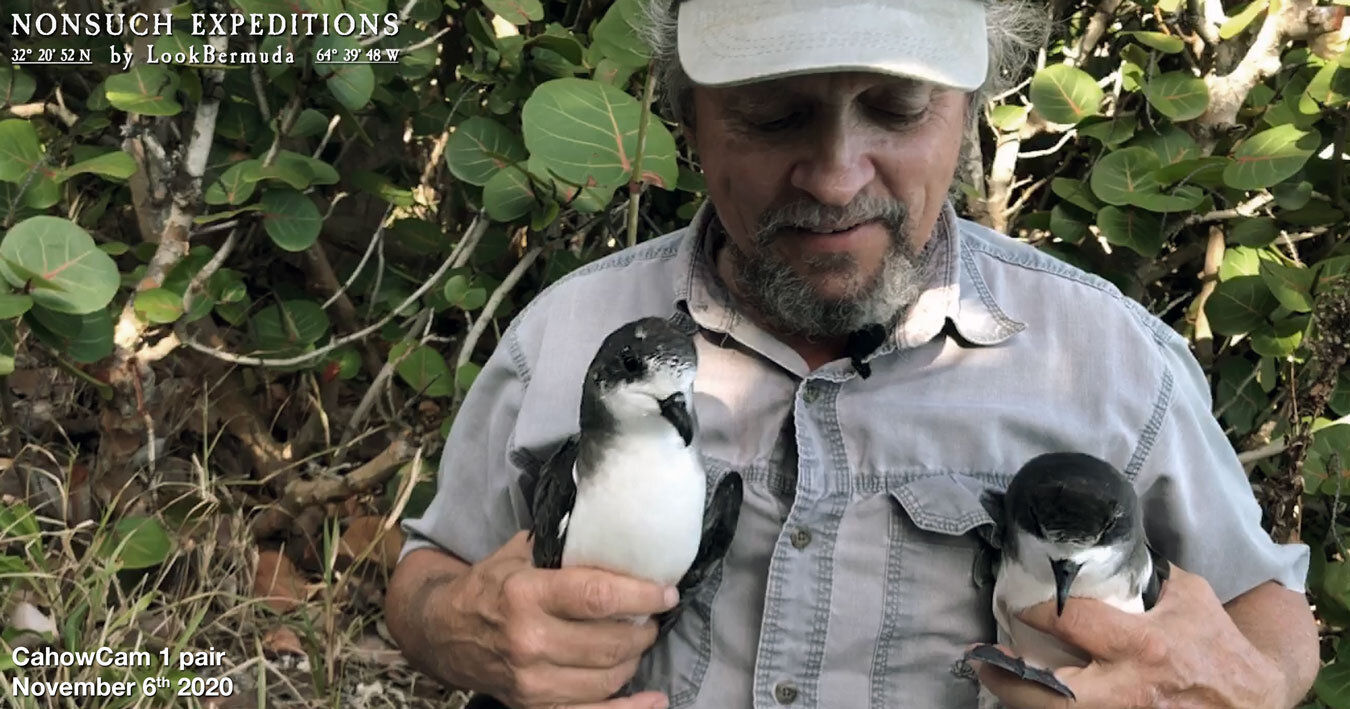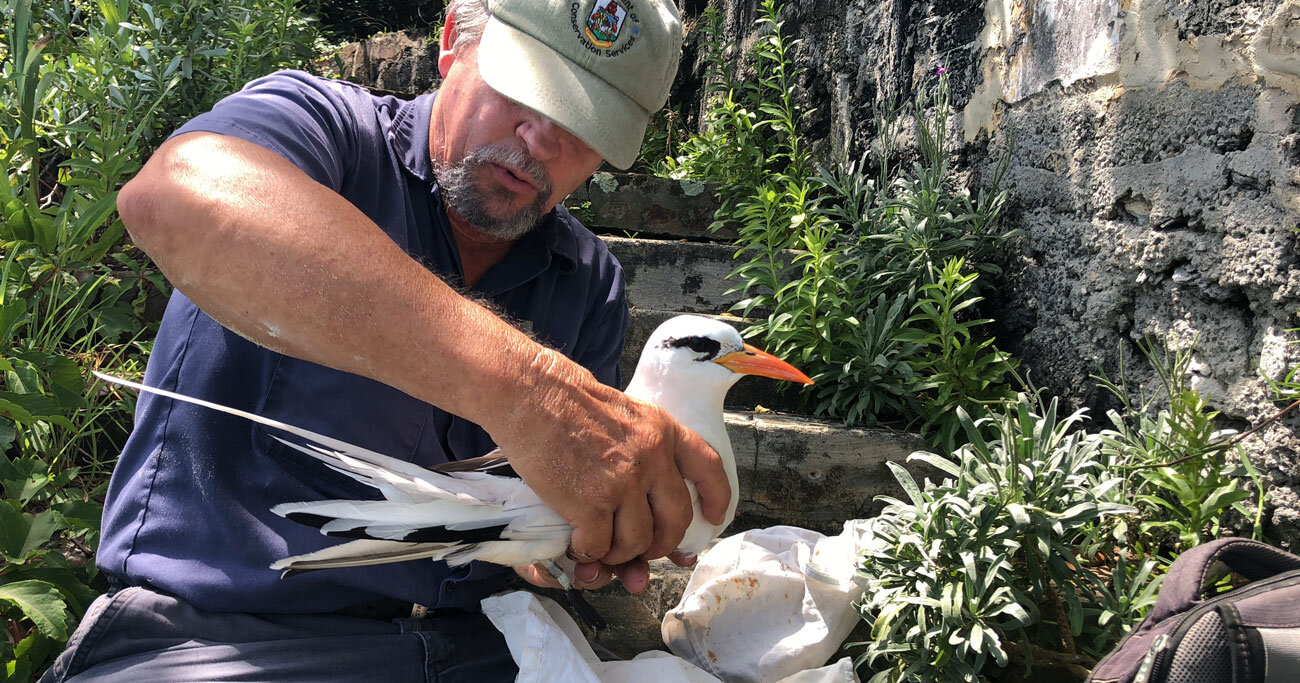Despite the disruption caused by the Covid-19 pandemic to human society and economies worldwide, recovery projects for Bermuda’s most endangered and iconic endemic species have been able to continue. There has been good news from the Recovery Project for Bermuda’s endangered National Bird, the endemic Cahow, or Bermuda Petrel (Pterodroma cahow). The Cahow’s 2020 breeding season saw its population increase to a record number of 134 breeding pairs, with 69 chicks confirmed as successfully fledging out to sea, just below 2019’s record number of 73 fledged chicks.
CahowCam 1 pair reveal egg January 10th 2020
The Cahow now nests on 6 islands in the Castle Harbour Islands Nature Reserve, ranging from just over half an acre to the 16.5-acre Nonsuch Island. These islands are kept free of introduced species such as rats through rigorous management and eradication efforts, as the Cahow cannot survive in the presence of introduced mammal predators, such as rats, cats, and dogs.
CahowCam 2 chick “Zephyr” at entrance of burrow June 4th 2020
Two colonies of Cahows were established on Nonsuch Island between 2004 and 2017 through the translocation of near-fledged chicks from the original small, eroding nesting islets, to artificial burrows constructed on Nonsuch. These chicks were then hand-fed daily and allowed to imprint upon the new location until they fledged about 3 weeks later. These projects were successful, with almost 50% of the translocated chicks returning 3 to 5 years later when mature to Nonsuch to choose nest sites and life- long mates.
The first of these returned pairs in 2009 produced the first cahow chick to naturally hatch on Nonsuch since the 1620s, and this new population has since increased to a total of 25 breeding pairs in 2020, making Nonsuch the second-largest Cahow breeding colony. This new population has already produced a total of 87 fledged chicks between 2009 and 2020! So far, 13 of these Nonsuch-born chicks have been recorded as returning to breed, including 9 settling back on Nonsuch, so these colonies are well on their way to becoming self-sustaining.
The Nonsuch Cahow colonies were primarily established as a response to increased erosion and flooding of the original tiny nesting islets from a combination of increased strong hurricanes over the last 25 years, coupled with accelerating sea-level rise due to the melting of ice caps and thermal expansion of warming oceans due to climate change.
Eye of Hurricane Paulette approaches Bermuda September 14th 2020
The value of the Nonsuch populations was proven during hurricanes “Paulette” and “Teddy” in September 2020. Two of the original nesting islets were completely submerged by the 21 to 28-foot waves of these two storms. Many of the artificial concrete nest burrows were damaged, with concrete nest lids washed overboard, burrows filled with debris, and quarter-ton boulders rolled across the nesting colonies, damaging burrows and requiring lengthy repairs. By contrast, the Nonsuch colonies, with burrows constructed at higher elevations than is possible on the smaller islets, were completely unaffected by the storms.
Charles Eldermire - Cornell Lab of Ornithology, Letizia Campioni - MARE-ISPA IU, Jeremy Madeiros - DENR, Monica Silva cE3c-FCUL, JP Rouja - Nonsuch Expeditions
A new, exciting project involving the at-sea tracking of Cahows using advanced GPS tags weighing only 3.3 grams apiece was started in 2019, with a partnership between the Department of Environment and Natural Resources, the Nonsuch Expeditions, and several international researchers. These include Letizia Campioni of Italy, Monica Silva of Portugal, Carina Gjerdrum of the Canadian Department of Environment and Climate Change, and Andre Raine of the Hawaii Endangered Seabird Recovery Project.
Monica Silva of Portugal, Jeremy Madeiros, Letizia Campioni of Italy
Jeremy Madeiros, Andre Raine of Hawaii, Carina Gjerdrum of Canada
Two types of GPS tags were used during egg incubation and early chick-rearing, tracking the at-sea movements of adult Cahows as they carried out feeding trips during these periods. These tags are accurate to within a meter or two, enabling tracking the movement of the birds very precisely, and even to determine the speed of the birds flying between their nests in Bermuda and the distant foraging areas. The information gained revealed that Cahows regularly carry out feeding trips to gather food for the growing chicks spanning thousands of miles, to the edge of the Canadian Continental Shelf, and beyond to the Grand Banks.
The first GPS track of Pterodroma cahow April 2019. A feeding trip by adult Cahow to Georges Bank (off Cape Cod) to gather food for its chick (Letizia Campioni).
GPS tracks of at-sea movement of female (purple) and male (green) adult Cahows during egg incubation Jan-Feb 2019. (Compiled by Letizia Campioni).
In addition, blood and feather samples were collected from nearly 90 Cahows, to investigate a number of factors, including testing for persistent organic contaminants, genetics, sexing, etc. We have already confirmed that the pesticide DDT and its breakdown component DDE, which caused the near-extinction of many bird species and contaminated many people until banned in North America in the early 1970s, is still present in most Cahows. Although the contamination is not in as high amounts as during the 1960s and early 1970s, when it contributed to breeding success rates as low as 27-28%, it is still present in high enough concentrations that it may be causing a reduction in breeding success. It may well be the reason why a relatively high percentage of eggs fail during incubation, keeping breeding success no higher than 53% to 60%, despite intensive management. By comparison, my other main study and management species on Bermuda, the Longtail or White-tailed Tropicbird, has breeding success rates ranging from 68% to nearly 80% at the study locations.
Researchers Letizia Campioni of Italy and Maria Diaz (with Birdlife International in the U.K.) visited Bermuda again between 22 January and 14 February 2020 and worked with me to fit 23 archival GPS tags, all of which have since been recovered. These helped us to determine that the Cahows foraged in very different areas much closer to Bermuda than in 2019 (400 – 800 miles, compared to 800 – 1250 miles). This may account for record-high weights of both adult Cahows and chicks in 2020, compared to those recorded over the last 18 years, which bodes well for the survival of the fledged chicks this year.
Although a second trip to Bermuda planned by Letizia in April was canceled due to the Covid-19 pandemic, funding is being secured for a third field season in 2021, which will hopefully provide additional information important for the survival of Bermuda’s amazing, and recovering National Bird.
Jeremy Madeiros, Principle Scientist – Terrestrial Conservation Section, Department of the Environment and Natural Resources



































